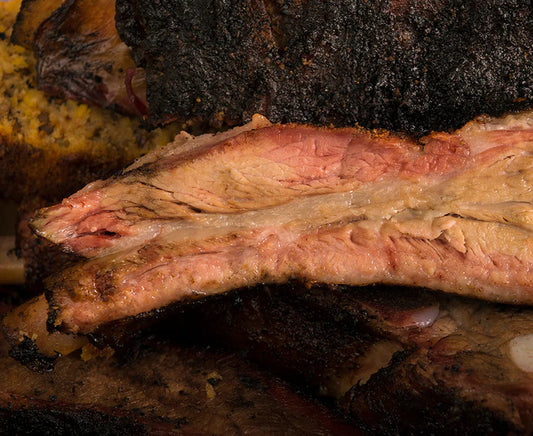For all those nervous to give sausage making a try, fear not, it’s easier than it may seem. I know the task may seem daunting and risky, but it is well worth the effort! And to help you along here is a guide to sausage making:
Tip #1: Keep Everything Cool, Clean and Clear
You will be handling and grinding raw meat. Grinding meat increases its surface area and increases the risk of bacterial contamination, as do warm temperatures.
So, keep your counter space clear, wash your hands thoroughly and wear disposable gloves. Also, lower the temperature of your kitchen, if possible, and place bowls and grinding equipment in the freezer shortly before use.
Use only metal or plastic equipment and cutting boards to reduce bacterial contamination, not wood. Remember, if you’re not handling the meat, put it back in the fridge. Assign a space in the fridge for your meat that is on the lowest shelf and away from all other food items, particularly fruit and vegetables. I placed a small baking sheet in the “sausage zone” to reserve the space and to catch any rogue meat or juices.
Tip #2: Start Small
It will take an attempt or two for you to get used to the process of sausage making. Therefore, don’t start off your very first batch with 10 lbs of meat. To test out your seasoning and your skills, start with a pound or two of meat.
Two lbs of meat will make approximately 12 sausages that are 4” long with standard hog casing. While honing your skills, it is best to work in small batches, so you need not stress about time, and the meat won’t sit out for longer than it should.
Tip #3: Be Prepared
Plan your attack. Prepare your station before you get your hands deep in raw meat. Make sure you have all of the ingredients and equipment you need beforehand. As a result, you will find yourself more relaxed and ready to take on the task. Assemble and test out equipment beforehand to make sure it works properly and you know how to use it.
Tip #4: Give Yourself More Time Than You Think
Think it will take you an hour to cut, grind, season, mix and stuff your sausage? You’re being unreasonably optimistic. It will take a couple of hours to prep sausage the first time around. Therefore, be realistic and make sure you have a good chunk of time.
Equipment
Cutting board
Knife
Bowls
Stand-up mixer
Meat grinder
Sausage stuffer
Needle
Smoker
Bradley Smoker wood bisquettes (your choice of flavour)
Sausage hooks
Meat thermometer
Baking dish
Ice
Instructions
This procedure is a general guideline for sausage preparation for smoking, and not a recipe.
- Cube your selected meat into pieces that will fit in your grinder. Keep in mind sausages work best with a meat to fat ratio of 80:20.
- Mix in the desired seasoning thoroughly with the paddle attachment in a stand mixer for no more than two minutes.
- Soak hog casing for 30 minutes, drain and then flush with fresh water. I find it easiest to work with 3 foot long pieces at a time.
- Lead casing over sausage stuffer until the length of the casing has been pushed onto the nozzle. Press through a small amount of meat to fill the stuffer nozzle.
- Tie end of hog casing – referred here as the “bottom” of the sausage chain. Continue stuffing sausage meat through with one hand, while retaining tension on casing with the other. Sausage should be tightly stuffed into casing, but be careful not to stuff too tightly. Otherwise it will be difficult to twist links, or you may tear the casing.
What to Do After Sausages are Stuffed
- Once all sausages are stuffed into casing, pull stuffed casing away from remaining casing on the nozzle. Then cut so as to leave a few inches of unstuffed casing attached to the stuffed casing. The end of the sausage chain where you finish will be referred to as the “top”.
- Starting at the bottom of the sausage chain, form links by twisting the casing. The sausage on the top end of the chain will be pushed up to make room for the twist in the chain. Hence why you must leave excess casing at the top end. Ensure sausage links are taught, well formed and relatively even in size. Continue as such until the top of the chain and tie the last link closed with loose casing.
- Cut excess casing on either end.
- Sterilize a sewing needle or pin in boiling water and prick any air pockets in the sausage.
- Pat sausage dry with a clean kitchen towel or leave hanging in a cool, dry place for an hour.
Time to Smoke Them
- Remove middle racks of smoker, leaving only the highest and lowest racks. You need the highest rack to suspend the sausage, while the lowest rack will act as a safety net if, heaven forbid, a sausage falls from its perch.
- Place sausage hooks evenly along top rack.
- Preheat smoker to 150°F with desired bisquettes and maintain a temperature of 140-160°F. Too hot and the sausage will dry out, too cold and it will take all day. In addition, you run the risk of exposing the sausage to temperatures in which bad bacteria can proliferate.
- Hang dried sausages evenly inside preheated smoker and smoke for 3-5 hours. Time will depend on the size of the sausages and the number of sausages inside the smoker. Or smoke them until you reach an internal temperature of 160°F. When stringing the chain of sausages to the hooks in the smoker try to keep them from touching as much as possible. Due to inconvenient forces, such as gravity, sausages will touch, so halfway through smoking rearrange the sausages within the smoker.
- Remove sausages from smoker and submerge in an ice bath until the internal temperature is reduced to 110°F. Allow sausages to cool further in the fridge. I did so in a closed container so apples and milk in the fridge don’t start tasting like smoked sausage.
- Enjoy and serve as you would cooked store-bought smoked sausages: cold as a snack, tossed into your favourite soup or pasta dish, etc.




